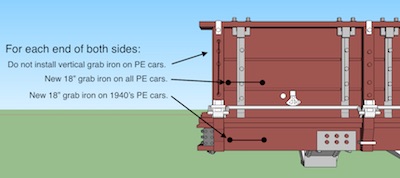Hart Gondolas on the Pacific Electric
December 07, 2015

The Pacific Electric’s Hart convertible gondolas were exact matches to the SP W-50-3 gondolas as they were built by the Southern Pacific and Union Pacific. These cars were initially numbered 6400-6449, but quickly changed to 6200-6249 by 1914. The equipment diagram for the cars (shown in Ira Swett’s Cars of the Pacific Electric vol. 3, 2nd edition) show a car with identical dimensions to the SP’s cars. Unlike the SP cars, the PE cars kept their side dump doors. A photo of car #6241 in Swett’s book shows the PE car at the end of its life: side dump doors still opening, latches on alternate doors, and the like. A separate photo in Thompson’s “Southern Pacific Freight Cars” shows a swaybacked string of Hart gondolas still in use in the late 1940’s; another photo (from the MTA archives) shows a Hart gondola in West Hollywood’s Sherman Shop complex, ready with a load of ballast.
The surviving photos do suggest two differences. The original cars SP had vertical handholds on each corner of the car. PE’s cars, as seen in a 1912 photo, instead show a horizontal grab iron on the sides about 14 inches above the floor of the car. By 1950, the PE added a second handhold on the side sill.
The other significant difference involves the wheels. As seen in the builder's photo in SP Freight Cars, the Pacific Electric gondolas were built with arch bar trucks. Later photos shows the cars with the same arch bars. These trucks differed from the arch bar trucks we normally see on HO models. Rather than having a bottom bar that sloped up from the bolster to the journal boxes, the bottom bar of these trucks was parallel to the rail.
If you’re a Pacific Electric modeler and want a string of Hart gondolas for your maintenance of way crew, the “SP car as built” model is nearly identical to the PE’s actual car. Omit the vertical handholds, and drill holes for the four new grab irons on each side. Note that our SP W-50-3 gondola kit contains some PE lettering on its decal sheet, but doesn't include the white Pacific Electric logo seen on 1940's freight cars. We don't know a good HO wheel set for those arch bar trucks, but suspect any of the commercial arch bar trucks would still look good under the car.
For more information:
Ed Workman, Common Standard Freight Cars: Pt. 1. In Union Pacific Historical Society Streamliner magazine, vol 11(4), 1997.
Ira Swett, “Cars of the Pacific Electric”, volume 3. Interurban Press, 1975. Diagram of the Pacific Electric 6200 series gondolas, and photo of car 6241 in the 1940’s.
Tony Thompson, “Southern Pacific Freight Cars Volume 1”. Photo of PE car in 1912 and another of a string of swaybacked gondolas in the 1940’s.
